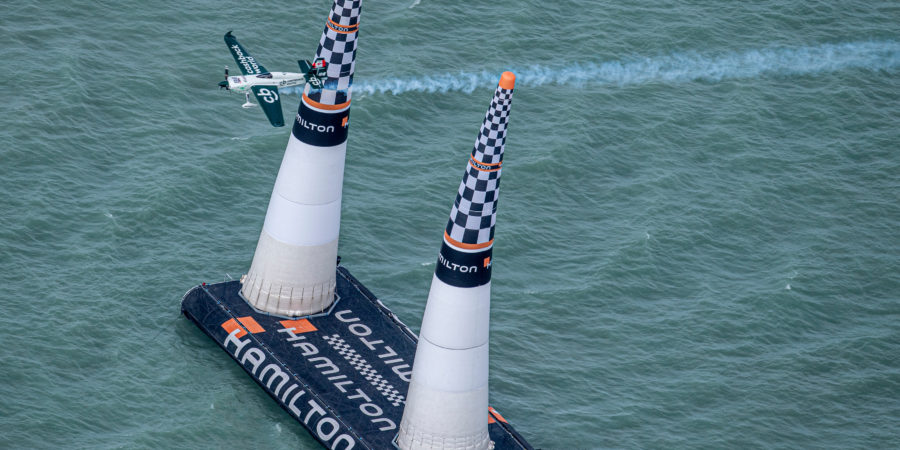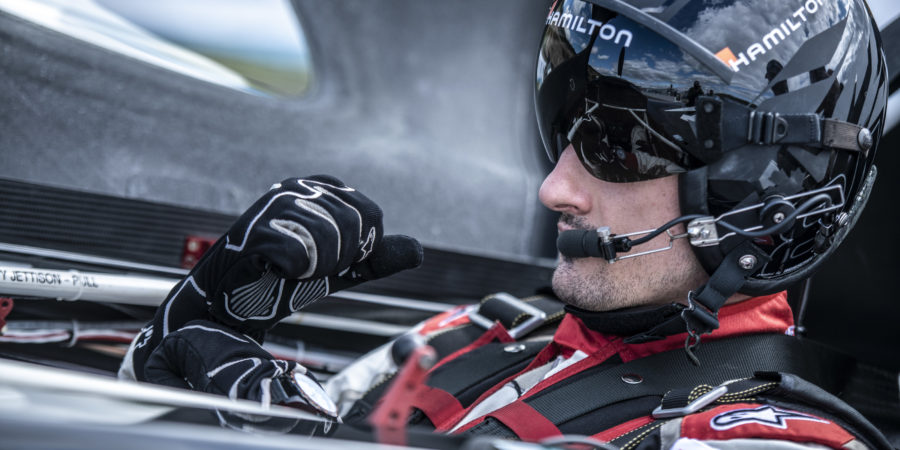The Golden Angle – what it takes to win in Air Racing
The recent Red Bull Air Race stop at Lake Balaton produced some of the most exciting action in
the sport’s 14 seasons. One of factors that made it so thrilling was the racetrack layout: the teams
had a wide variety of trajectories to try in the quest to shave time off their runs. Canada’s
Cashback World Racing Team explain how they found the magic line.
The Canadian team worked out the track brilliantly, and it was far from guesswork. Pilot Pete
McLeod finished third, just 0.127s away from race winner Matt Hall (AUS) and a mere 0.009s
behind second place Ben Murphy (GBR). The result was a complete change in fortunes after
finishing ninth in the first two races of 2019.
Expert tactician Werner Wolfrum joined McLeod’s team at the start of this season, but the
German is no novice: he was formerly part of Hannes Arch’s team (AUT) and knows how to find
that winning line. “My special skill is that I have developed tools to show Pete the comparisons in
a 3D visualisation,” says Wolfrum. “We can move our viewpoint around a pattern and can
compare using a look at the line ahead, to see how it will proceed in the next seconds. A picture
tells more than thousands of words, and an animated 3D view more than a million…”
The key to the race
Wolfrum knows exactly where McLeod took his advantage over other pilots. “In Balaton, Gate 5
[which was also Gate 13] was the challenge and key, especially with the wind. Taking it flatter
increased the effect to ‘surf’ on the wind drag, but with the danger to hit the Track Limit Line. To
take it vertical is safe against the Track Limit Line, but consumes more energy,” explains
Wolfrum. “This is where we needed to find the ‘Golden Angle’, and it was not easy to estimate,
especially because the changing wind had a huge effect.”
The ‘Golden Angle’ is a term that Wolfrum uses for the perfect line through a particularly tricky
gate. Finding – and explaining – it takes more than just throwing some numbers at the pilot. “It
makes no sense to give the pilot a mathematical expression or tell him, ‘These are the track
parameters, fly it…’” Wolfrum asserts. “The only way that he can use and work with the input is to
develop a feeling about the shortest line. That – in my opinion – is only possible in a close
discussion of the options in the track. The pilot has the most experience, always more than a
tactician. So the feedback from my pilot is at least as important as the data we get out of the
download after a run.”
To make the line options almost tangible in those discussions, Wolfrum not only used his virtual
tool but also employed a simple piece of paper, curving it as if it were the trajectory of the
raceplane to show McLeod the various effects: if he went flatter (a comparatively broad curve), he
would surely touch the Track Limit Line, and if he pulled too strongly vertical (a tight initial curve)
he would get some space but would slow down due to losing energy in the plane. A radius
somewhat wider than vertical would be ideal, but what angle was optimal?
At Balaton, the changing winds that Wolfrum mentions altered the conditions of the track, and
how the pilots needed to fly it, so frequently that almost every session was different. The pilots
went from rain and 22-knot wind to no wind and glorious sunshine. And the Golden Angle
changed with those conditions. “When there’s more wind from the sides, you can take a little bit
flatter line because the wind drags you away from the Track Limit Line,” Wolfrum describes. “We
discussed watching the wind before entering the track. Maybe you can get information that can
help you estimate the wind, for example, from smoke coming out of a smokestack, or the waves
on the water or how the pylons move. If you have more wind, then a little bit more angle is
possible, about five or 10 degrees.”
But when flying at 200kts, five or 10 degrees is difficult to judge – let alone execute. Wolfrum
says, “That feeling when driving very fast that the road becomes more and more narrow? You
have to imagine that: to get the right target as things feel closer and closer, 10 degrees is really
nothing at that speed. And that is what I am always fascinated by. That these millimetres on the
stick work under 10G at that speed. This is only possible if pilots feel a bond with their plane, the
extended body.” He goes on, “Nuances – millimetres – make a huge difference, and it could be
easy to do too much. So Pete needs to feel it, to sense it on his own, not by a number or an angle
I could give him.”
McLeod emphasises Wolfrum’s value to the team. “Werner pays attention to ALL details of
analysis… from engine and aircraft setup to the line being flown, including 3D modelling and
analysis, and even the efficiency of HOW that line is flown. It’s not just the path you fly, but how it
is flown that can make a huge difference in today’s Red Bull Air Race!”
Teamwork to find the best line
Every team has their own unique way of working together. So when there is a tricky line, or
something is not going to plan, how do Team McLeod come to a solution?
“I point out the options I see, and Pete maybe has other options in his view, and we discuss
[them],” Wolfrum shares. “The best thing is to talk about it, and then Pete has the same
visualisation of the track, because he has to fly it.”He continues, “For Pete, the most important
thing is going through the track in his mind. The target is to open Pete’s mind to different views
because he has to see the different options and all possibilities, and then he, and only he, can
select the right one, because he knows and he feels what his plane does.”
Wolfrum hasprogrammed his simulator for both training and visualisation. McLeod elected not to
train for Balaton in the simulator because it cannot give him the feeling of G loads, and he did not
want to rehearse movements that might need to be slightly different when actually experiencing
high G. But, to develop the countless visualisations he did in his mind and using a “racetrack” laid
out on his hangar floor, the simulator was very helpful. With it, Wolfrum and McLeod were able to
move through every point in the track, around the track, from the outside, from the sides, from
directly in front of a gate. And that is the other function of Wolfrum’s simulator. To put out all data
from the plane, combine it into the line in the simulator, and then look at it virtually from all sides.
“These kind of discussions work out, or make clear, the components and the relations in Pete’s
mind so that he see the combinations,” Wolfrum notes. “Pete’s skill allows him to work with such
information extremely well to find the right way.”
McLeod reciprocates Wolfrum’s appreciation with praise for the 3D tool his tactician has
produced: “The pilot ultimately has to go out and complete the line and will always be limited by
human factors… this is why this tool works so well, because coaching the pilot visually is a very
efficient way to deliver the information.”
See the world’s best Air Racing pilots fly their lines at the season finale in Chiba, Japan on 7-8
September 2019: For ticket information and all the latest, visit www.redbullairrace.com.
###
Red Bull Air Race 2019 Calendar
8-9 February: Abu Dhabi, UAE
15-16 June: Kazan, Russia
13-14 July: Lake Balaton, Hungary
7-8 September: Chiba, Japan
About Red Bull Air Race
The Red Bull Air Race World Championship is an aerial motorsport series that demands a
combination of speed, precision and skill. Using the fastest, most agile, high performance
raceplanes, pilots compete in iconic locations over water and land. The high speed, low altitude
and extreme manoeuvrability required make it accessible only to the world’s most exceptional
pilots.
Flying just metres from the ground, 14 Master Class pilots race against the clock whilst reaching
speeds of up to 370 km/h, requiring a combination of precision and skill unmatched in the world of
aviation. Pilots must be in peak physical condition as they endure forces up to 12G while
navigating the technical racetracks made up of air-filled pylons.
The Air Race was developed in 2003 and is accredited by the Fédération Aéronautique
Internationale (FAI), with more than 90 races completed across five continents. As the most
advanced aerial challenge in existence, competing in the Red Bull Air Race World Championship
is the highest accolade for elite pilots. The Challenger Cup feeder series was introduced in 2014.
For more editorial content, visit www.redbullairracenewsroom.com.

